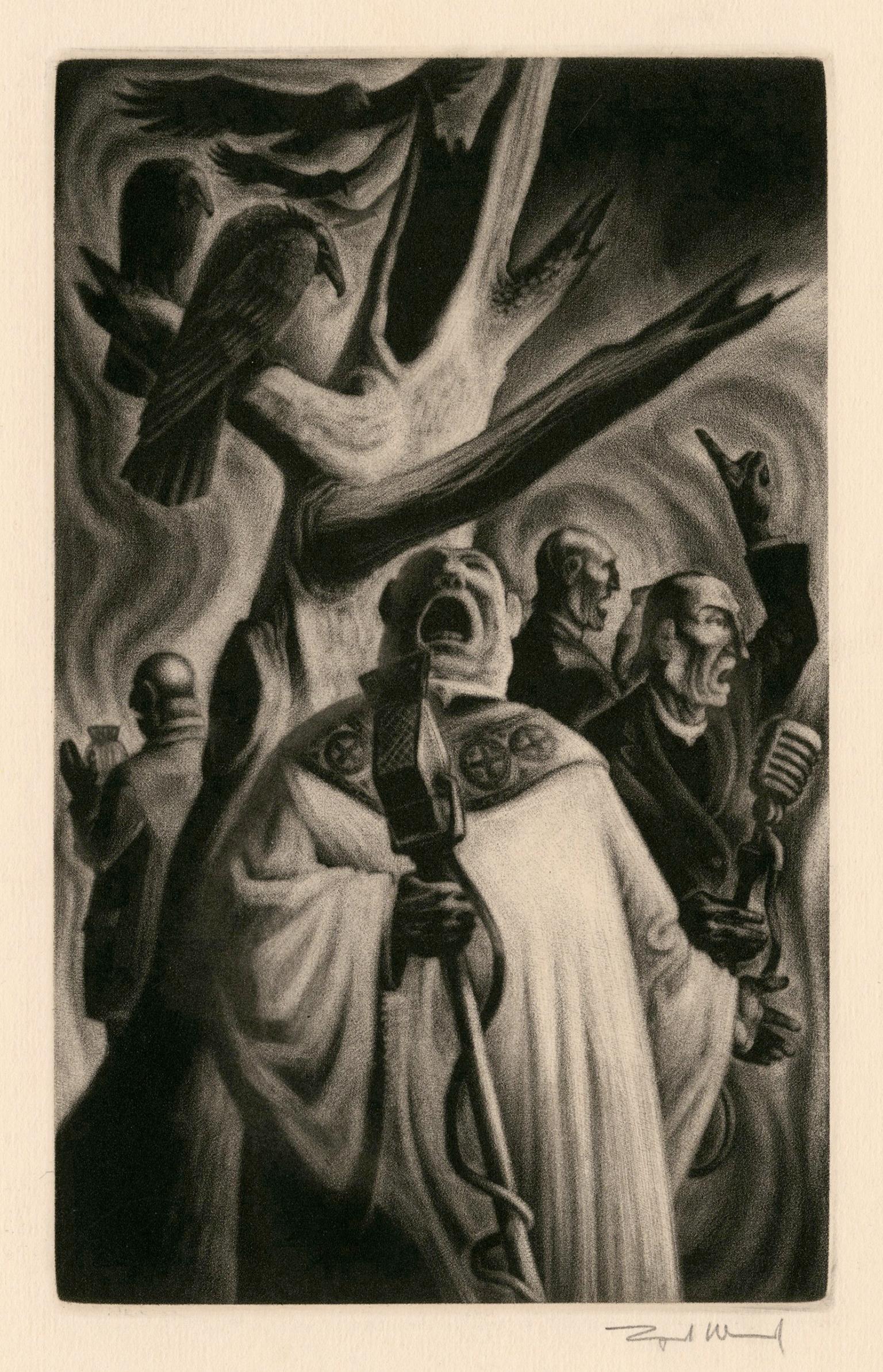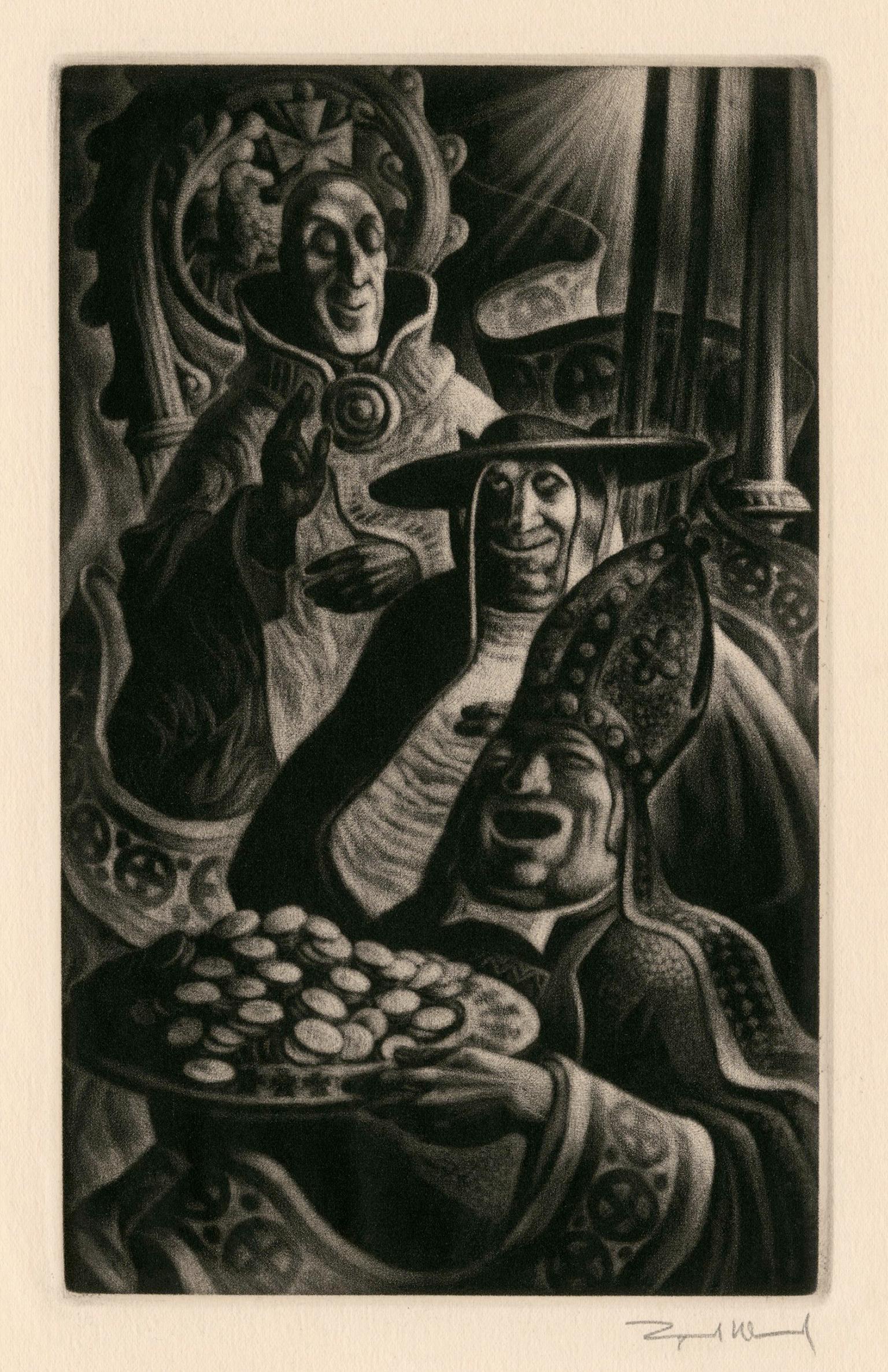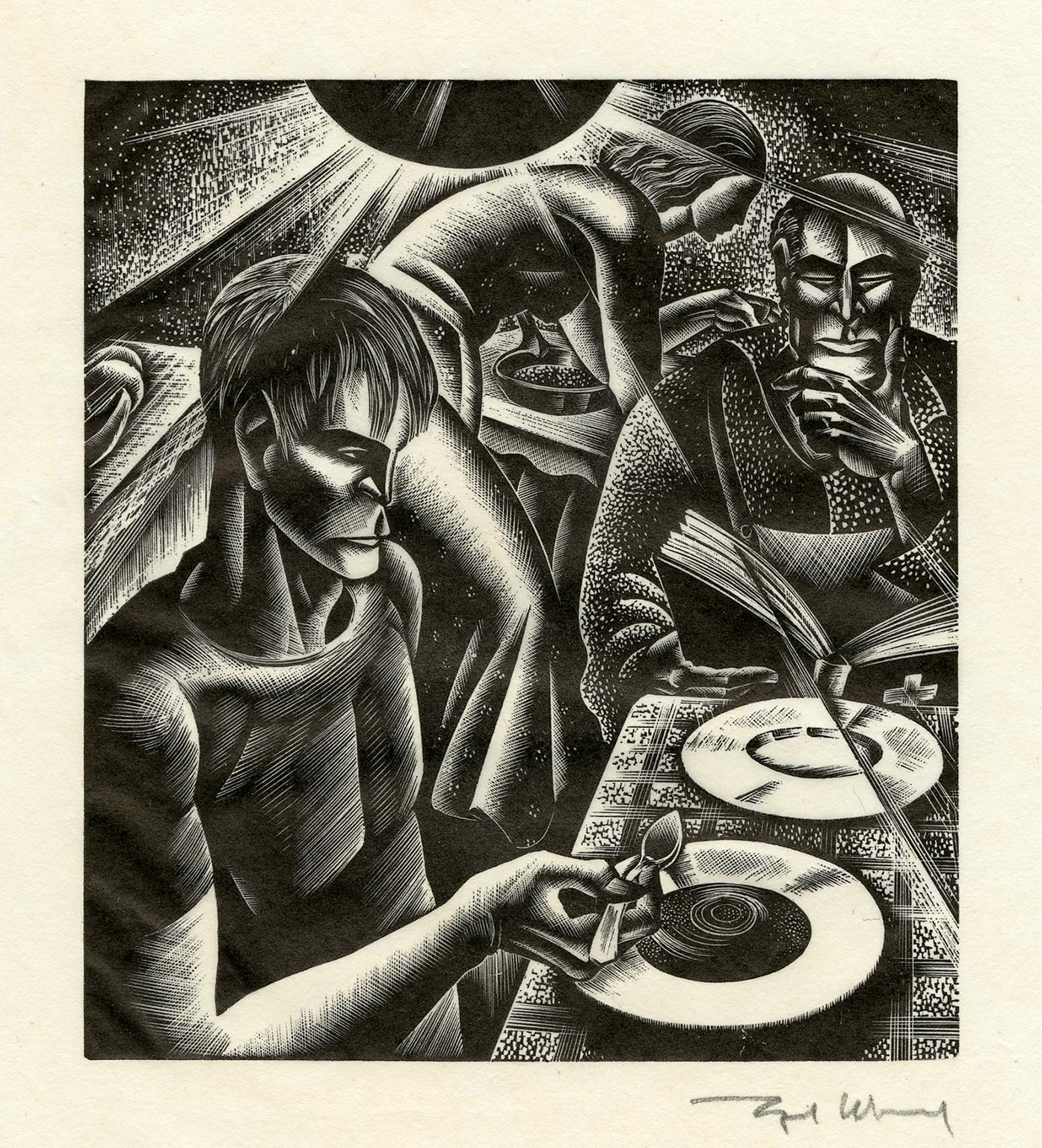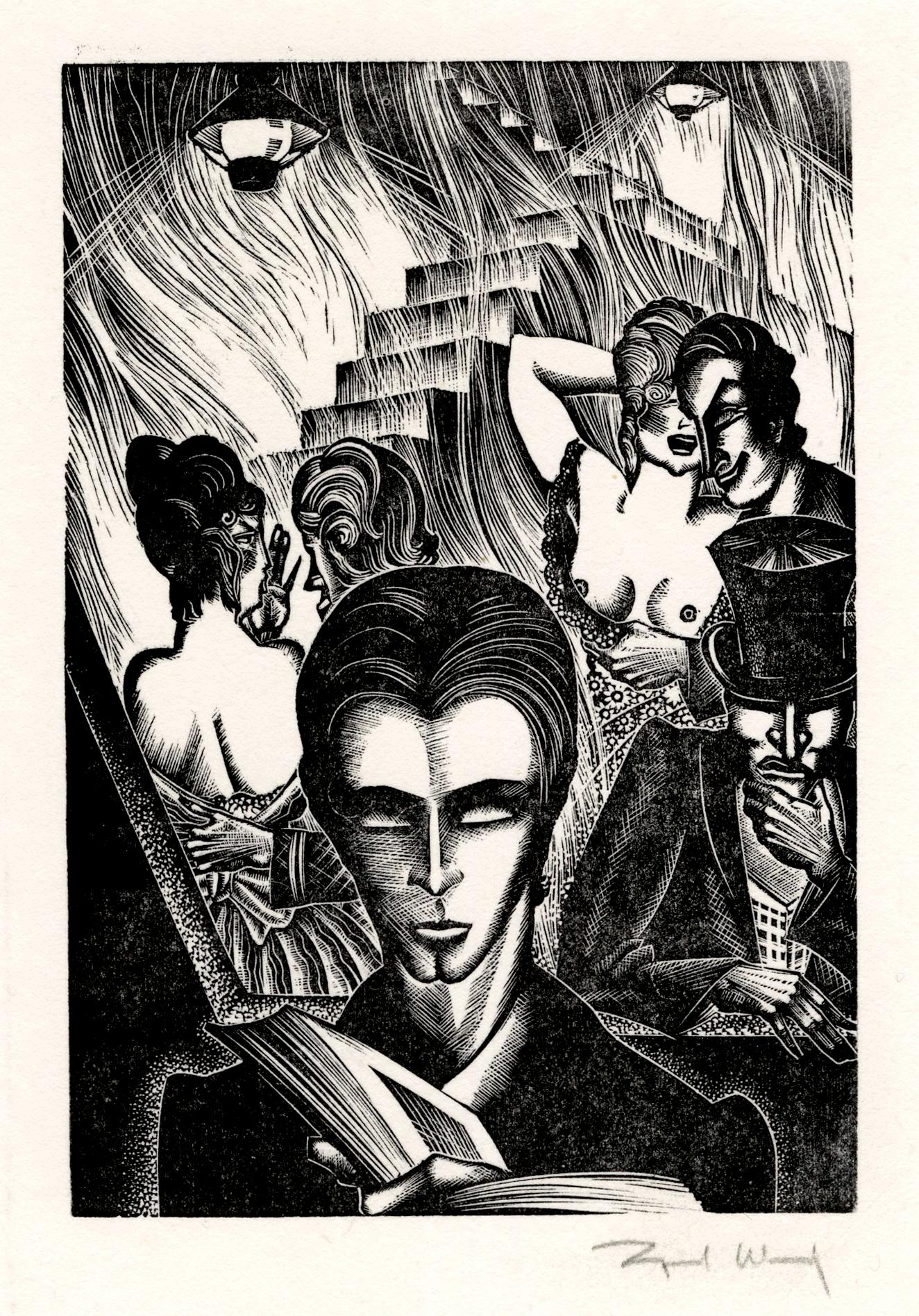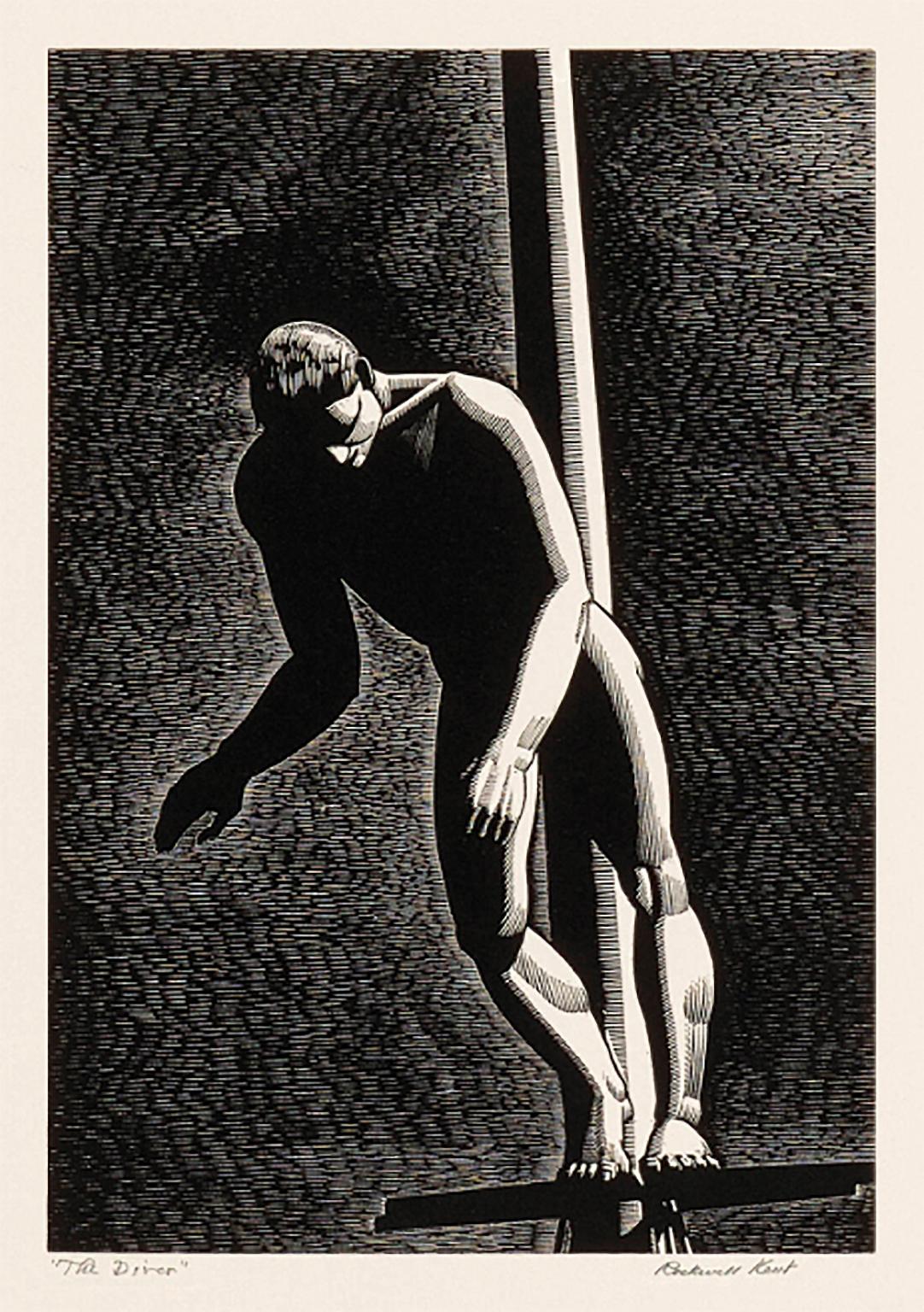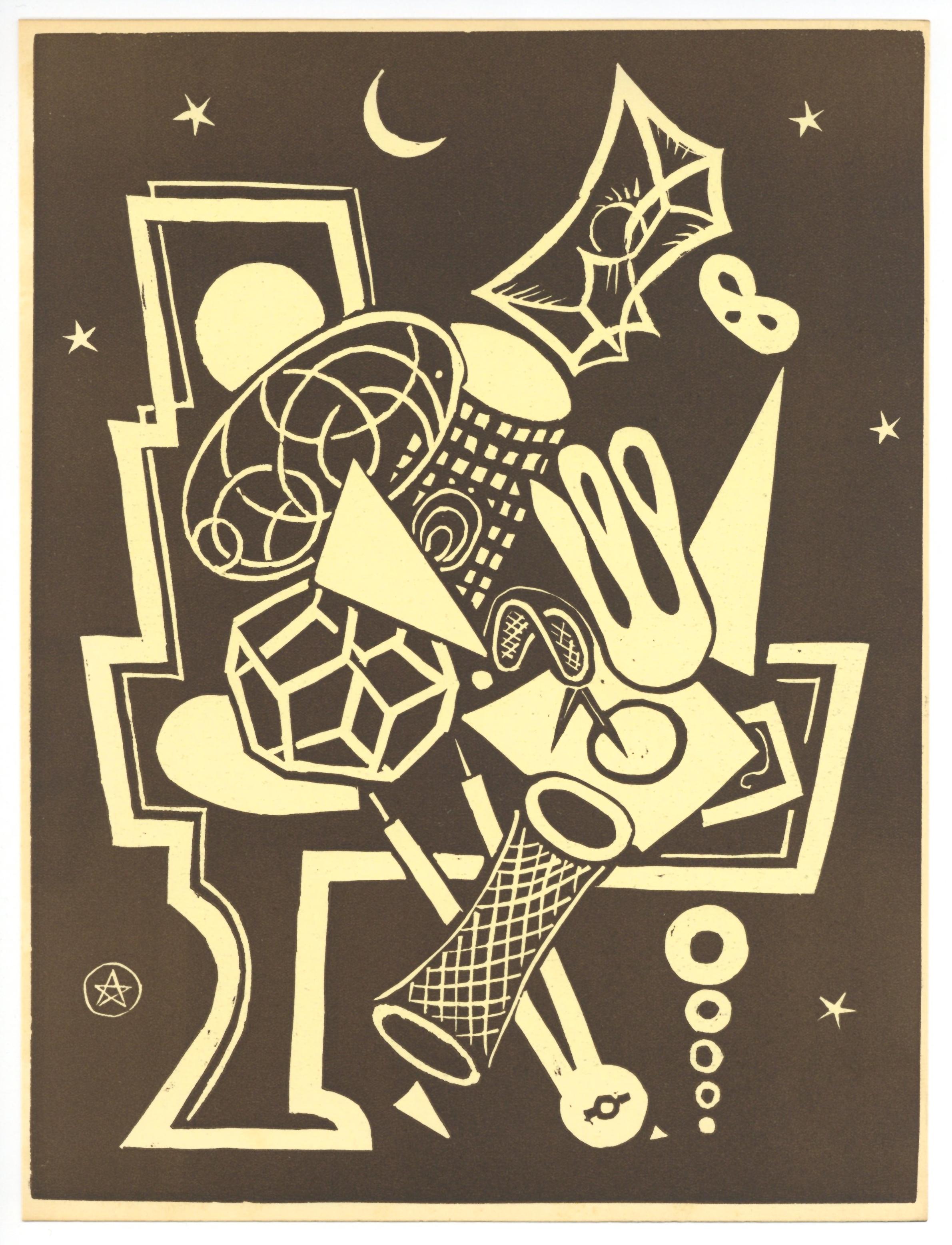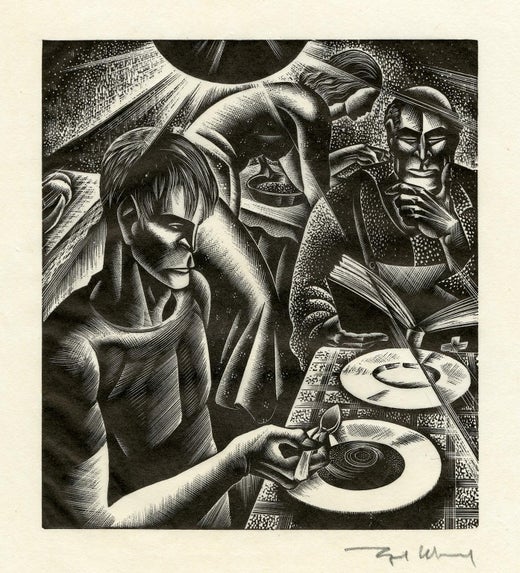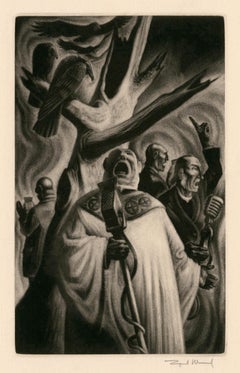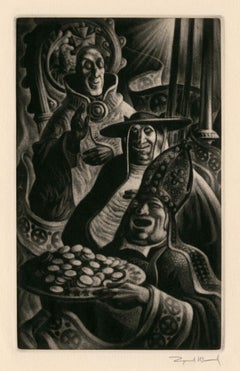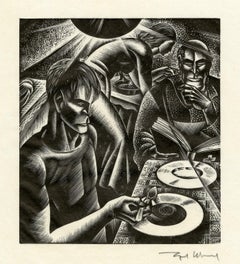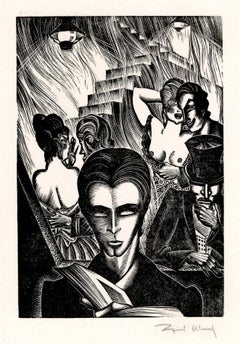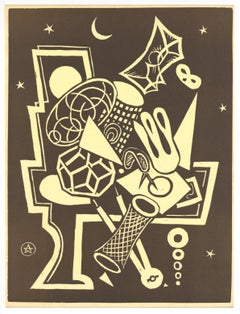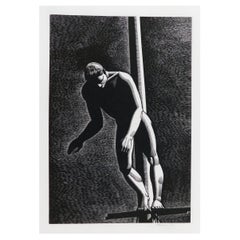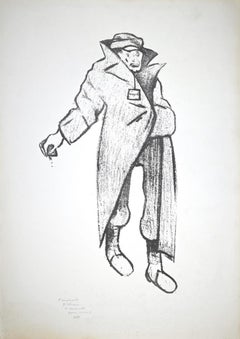Items Similar to 'Doctor' from 'In Praise of Folly' — Mid-Century Graphic Modernism
Want more images or videos?
Request additional images or videos from the seller
1 of 3
Lynd Ward'Doctor' from 'In Praise of Folly' — Mid-Century Graphic Modernism1943
1943
$850
£644.51
€744.41
CA$1,192.60
A$1,328.53
CHF 700.78
MX$16,108.86
NOK 8,914.93
SEK 8,304.82
DKK 5,558.77
About the Item
Lynd Ward, 'Doctor' from the series 'Moriae Encomium (In Praise of Folly),' mezzotint, 1943, no edition, proofs only. Signed in pencil. A superb, richly-inked impression, on cream wove paper; the full sheet with margins (1 to 1 3/4 inches) in excellent condition. Matted to museum standards, unframed. Scarce.
Image size 7 3/4 x 4 3/4 inches (197 x 121 mm); sheet size 10 11/16 x 8 1/16 inches (271 x 204 mm).
Created by the artist for 'Erasmus's Moriae Encomium,' or 'In Praise of Folly,' published by the Limited Editions Club, 1943. A rare, signed, proof impression apart from the Limited Editions Club publication.
ABOUT THE ARTIST
Lynd Ward is acknowledged as one of America’s foremost wood engravers and book illustrators of the first half of the twentieth century. His innovative use of narrative printmaking as a stand-alone storytelling vehicle was uniquely successful in reaching a broad audience. The powerful psychological intensity of his work, celebrated for its dynamic design, technical precision, and compelling dramatic content, finds resonance in the literature of Poe, Melville, and Hawthorne. Like these classic American writers, Ward was concerned with the themes of man’s inner struggles and the role of the subconscious in determining his destiny. An artist of social conscience during the Great Depression and World War II, he infused his graphic images with his unique brand of social realism, deftly portraying the problems that challenged the ideals of American society.
The son of a Methodist preacher, Lynd Ward, moved from Chicago to Massachusetts at an early age. He graduated from the Teachers College of Columbia University, New York, in 1926, where he studied illustration and graphic arts. He married May Yonge McNeer in 1936 and left for Europe for their honeymoon in Eastern Europe. After four months, they settled in Leipzig, where Ward studied at the National Academy of Graphic Arts and Bookmaking. Inspired by Belgian expressionist artist Frans Masereel's graphic novel ‘The Sun,’ and another graphic novel by the German artist Otto Nückel, ‘Destiny,’ he determined to create his own "wordless" novel. Upon his return to America, Ward completed his first book, ‘God's Man: A Novel in Woodcuts,’ published in 1929. ‘Gods’ Man’ was a great success for its author and publisher and was reprinted four times in 1930, including a British edition. This book and several which followed it, ‘Madman’s Drum,’ 1930, ‘Wild Pilgrimage,’ 1932, ‘Prelude to a Million Years,’ 1933, ‘Song Without Words,' 1936, ‘Vertigo,’ 1937; and ‘Last Unfinished Wordless Novel’ (created in the 1960s and published in 2001) were comprised solely of Ward's wood engravings. Ward designed each graphic image to occupy an entire page, the sequence of which conveys the story's narrative.
In 1937, Ward was named Director of the Graphic Arts Division of the Federal Art Project, a division of the Works Progress Administration (WPA). In the following years, Ward went on to illustrate more than one hundred books (some of which he wrote), including classics for the Limited Editions Club Goethe’s ‘Faust,’ Faulkner’s ‘A Green Bough,’ and Mary Shelley’s ‘Frankenstein,’ and several children’s books. He also produced single-subject wood engravings, paintings, and drawings. His print ‘Sanctuary,’ 1939, was shown at the 1939 New York World’s Fair, and ‘Clouded Over,’ 1948, received the 1948 Library of Congress Award and was included in ‘American Prize Prints of the 20th Century’ by Albert Reese. He received the National Academy of Design Print Award (1949), the New York Times Best Illustrated Award (1973), and the Regina Award (Catholic Library Association, 1975). ‘The Biggest Bear,’ a children’s book with illustrations by Ward, was the recipient of the esteemed 1952 Caldecott Medal of the American Library Association.
An Honorary Fellow of the Royal Society of Painter-Etchers and Engravers, Ward was a member and board member of the National Academy of Design and the Artists’ League of America. He served several terms as president of the Society of American Graphic Artists and was a member of the American Artists Congress and the Society of Illustrators. Ward exhibited at the American Artists Congress; the National Academy of Design; the John Herron Art Institute; and the Library of Congress. He had a one-person show at Associated American Artists, NY, on the publication of his monograph 'Storyteller Without Words,' 1974; AAA mounted a memorial exhibition in 1986. The May 1976 issue of 'Bibliognost,' a book collector’s publication, was dedicated to Ward. ‘Lynd Ward, His Bookplate Designs,’ an article by Dan Burne Jones, was published in the American Society of Bookplate Collectors and Designers Yearbook, 1981/82.
In 2001, sixteen years after his death, Rutgers University Libraries published ’Lynd Ward’s Last Unfinished Wordless Novel.’ The blocks were intended to be part of a novel in woodcuts, the first since Vertigo, but Ward did not live to complete the project. Master printer and book designer Barbara Henry collated and printed the twenty-six finished blocks out of the forty-four initially planned for the still unnamed narrative.
In 2010 the Library of America honored Ward’s achievements with the meticulous production of a collection of Ward’s woodcut novels—the first time the Library had gone wordless. The publication replicated his original editions with a single full-size image printed on the right page of each double-page spread. In his introduction to the books, renowned cartoonist/illustrator Art Spiegelman comments, “Ward had a genius for caving human movement, and watching his characters walk through their storylines is a particular joy of his novels. You see a very tightly woven narrative that rewards contemplation and a revisiting of how it’s told as well as what’s being told. Each of his books teaches itself. As you’re reading, you understand better how to read each book—the speech and rhythms of what one can find as one revisits a picture. The whole point of Ward’s work is to make you look and understand.”
The Grolier Club in New York mounted a one-person exhibition of Ward’s work from November 19, 2015, through January 16, 2016, displaying the wide range of his graphic accomplishments in woodcuts, lithography and mezzotint, brush drawings, line drawings, watercolors, and paintings.
An extensive archive of work by Lynd Ward is in the Georgetown University Art Collection, Washington, DC. Among the many other public collections representing his work is the Baltimore Museum of Art, British Museum, Cleveland Museum of Art, Farnsworth Art Museum, Fine Arts Museums of San Francisco, Georgetown University, Library of Congress, McNay Art Museum, Newark Museum, New York Public Library, Metropolitan Museum of Art, Museum of Modern Art, Pennsylvania Academy of the Fine Arts, Pennsylvania State University, Philadelphia Museum of Art, Rhode Island School of Design, Smithsonian American Art Museum, University of Chicago, and the Zimmerli Art Museum (Rutgers University).
- Creator:Lynd Ward (1905 - 1985, American)
- Creation Year:1943
- Dimensions:Height: 7.75 in (19.69 cm)Width: 4.75 in (12.07 cm)Depth: 0.01 in (0.26 mm)
- Medium:
- Movement & Style:
- Period:
- Condition:
- Gallery Location:Myrtle Beach, SC
- Reference Number:Seller: 1037661stDibs: LU532312094362
Lynd Ward
Lynd Ward was an American artist and storyteller, known for his series of wordless novels using wood engraving, and his illustrations for juvenile and adult books. His wordless novels have influenced the development of the graphic novel. Strongly associated with his wood engravings, he also worked in watercolor, oil, brush and ink, lithography and mezzotint. Ward was the son of Methodist minister and political organizer Harry F. Ward.
About the Seller
5.0
Recognized Seller
These prestigious sellers are industry leaders and represent the highest echelon for item quality and design.
Platinum Seller
Premium sellers with a 4.7+ rating and 24-hour response times
Established in 1995
1stDibs seller since 2016
311 sales on 1stDibs
Typical response time: 1 hour
Associations
International Fine Print Dealers Association
- ShippingRetrieving quote...Shipping from: Myrtle Beach, SC
- Return Policy
Authenticity Guarantee
In the unlikely event there’s an issue with an item’s authenticity, contact us within 1 year for a full refund. DetailsMoney-Back Guarantee
If your item is not as described, is damaged in transit, or does not arrive, contact us within 7 days for a full refund. Details24-Hour Cancellation
You have a 24-hour grace period in which to reconsider your purchase, with no questions asked.Vetted Professional Sellers
Our world-class sellers must adhere to strict standards for service and quality, maintaining the integrity of our listings.Price-Match Guarantee
If you find that a seller listed the same item for a lower price elsewhere, we’ll match it.Trusted Global Delivery
Our best-in-class carrier network provides specialized shipping options worldwide, including custom delivery.More From This Seller
View All'Priests' from 'In Praise of Folly' — Mid-Century Graphic Modernism
By Lynd Ward
Located in Myrtle Beach, SC
Lynd Ward, 'Priests' from the series 'Moriae Encomium (The Praise of Folly)', mezzotint, 1943, no edition, proofs only. Signed in pencil. A superb, richly-inked impression, on cream wove paper; the full sheet with margins (1 1/4 to 2 inches) in excellent condition. Matted to museum standards, unframed. Scarce.
Image size 7 3/4 x 4 3/4 inches (197 x 121 mm); sheet size 10 11/16 x 8 1/16 inches (271 x 204 mm).
Created by the artist for 'Erasmus's Moriae Encomium,' or 'In Praise of Folly,' published by the Limited Editions Club, 1943. A rare, signed, proof impression apart from the Limited Editions Club publication.
ABOUT THE ARTIST
Lynd Ward is acknowledged as one of America’s foremost wood engravers and book illustrators of the first half of the twentieth century. His innovative use of narrative printmaking as a stand-alone storytelling vehicle was uniquely successful in reaching a broad audience. The powerful psychological intensity of his work, celebrated for its dynamic design, technical precision, and compelling dramatic content, finds resonance in the literature of Poe, Melville, and Hawthorne. Like these classic American writers, Ward was concerned with the themes of man’s inner struggles and the role of the subconscious in determining his destiny. An artist of social conscience during the Great Depression and World War II, he infused his graphic images with his unique brand of social realism, deftly portraying the problems that challenged the ideals of American society.
The son of a Methodist preacher, Lynd Ward, moved from Chicago to Massachusetts at an early age. He graduated from the Teachers College of Columbia University, New York, in 1926, where he studied illustration and graphic arts. He married May Yonge McNeer in 1936 and left for Europe for their honeymoon in Eastern Europe. After four months, they settled in Leipzig, where Ward studied at the National Academy of Graphic Arts and Bookmaking. Inspired by Belgian expressionist artist Frans Masereel's graphic novel ‘The Sun,’ and another graphic novel by the German artist Otto Nückel, ‘Destiny,’ he determined to create his own "wordless" novel. Upon his return to America, Ward completed his first book, ‘God's Man: A Novel in Woodcuts,’ published in 1929. ‘Gods’ Man’ was a great success for its author and publisher and was reprinted four times in 1930, including a British edition. This book and several which followed it, ‘Madman’s Drum,’ 1930, ‘Wild Pilgrimage,’ 1932, ‘Prelude to a Million Years,’ 1933, ‘Song Without Words,' 1936, ‘Vertigo,’ 1937; and ‘Last Unfinished Wordless Novel’ (created in the 1960s and published in 2001) were comprised solely of Ward's wood engravings. Ward designed each graphic image to occupy an entire page, the sequence of which conveys the story's narrative.
In 1937, Ward was named Director of the Graphic Arts Division of the Federal Art Project, a division of the Works Progress Administration (WPA). In the following years, Ward went on to illustrate more than one hundred books (some of which he wrote), including classics for the Limited Editions Club Goethe’s ‘Faust,’ Faulkner’s ‘A Green Bough,’ and Mary Shelley’s ‘Frankenstein,’ and several children’s books. He also produced single-subject wood engravings, paintings, and drawings. His print ‘Sanctuary,’ 1939, was shown at the 1939 New York World’s Fair, and ‘Clouded Over,’ 1948, received the 1948 Library of Congress Award and was included in ‘American Prize Prints of the 20th Century’ by Albert Reese. He received the National Academy of Design Print Award (1949), the New York Times Best Illustrated Award (1973), and the Regina Award (Catholic Library Association, 1975). ‘The Biggest Bear,’ a children’s book with illustrations by Ward, was the recipient of the esteemed 1952 Caldecott Medal of the American Library Association.
An Honorary Fellow of the Royal Society of Painter-Etchers and Engravers, Ward was a member and board member of the National Academy of Design and the Artists’ League of America. He served several terms as president of the Society of American Graphic Artists and was a member of the American Artists Congress and the Society of Illustrators. Ward exhibited at the American Artists Congress; the National Academy of Design; the John Herron Art Institute; and the Library of Congress. He had a one-person show at Associated American Artists, NY, on the publication of his monograph 'Storyteller Without Words,' 1974; AAA mounted a memorial exhibition in 1986. The May 1976 issue of 'Bibliognost,' a book collector’s publication, was dedicated to Ward. ‘Lynd Ward, His Bookplate Designs,’ an article by Dan Burne Jones, was published in the American Society of Bookplate Collectors and Designers Yearbook, 1981/82.
In 2001, sixteen years after his death, Rutgers University Libraries published ’Lynd Ward’s Last Unfinished Wordless Novel.’ The blocks were intended to be part of a novel in woodcuts, the first since Vertigo, but Ward did not live to complete the project. Master printer and book designer Barbara Henry collated and printed the twenty-six finished blocks out of the forty-four initially planned for the still unnamed narrative.
In 2010 the Library of America honored Ward’s achievements with the meticulous production of a collection of Ward’s woodcut novels—the first time the Library had gone wordless. The publication replicated his original editions with a single full-size image printed on the right page of each double-page spread. In his introduction to the books, renowned cartoonist/illustrator Art...
Category
1940s American Modern Figurative Prints
Materials
Mezzotint
'Pope' from 'In Praise of Folly' — Mid-Century Graphic Modernism
By Lynd Ward
Located in Myrtle Beach, SC
Lynd Ward, 'Pope' from the series 'Moriae Encomium (In Praise of Folly),' mezzotint, 1943, no edition, proofs only. Signed in pencil. Annotated 'POPE - CARDINAL - BISHOP' - 1943 in ink, lower left. A superb, richly-inked impression, on cream wove paper; the full sheet with margins (1 3/8 to 1 7/8 inches) in excellent condition. Matted to museum standards, unframed. Scarce.
Created by the artist for 'Erasmus's Moriae Encomium,' or 'In Praise of Folly,' published by the Limited Editions Club, 1943. A rare, signed, proof impression apart from the Limited Editions Club publication.
Image size 7 3/4 x 4 3/4 inches (197 x 121 mm); sheet size 10 11/16 x 8 1/16 inches (271 x 204 mm).
ABOUT THE ARTIST
Lynd Ward is acknowledged as one of America’s foremost wood engravers and book illustrators of the first half of the twentieth century. His innovative use of narrative printmaking as a stand-alone storytelling vehicle was uniquely successful in reaching a broad audience. The powerful psychological intensity of his work, celebrated for its dynamic design, technical precision, and compelling dramatic content, finds resonance in the literature of Poe, Melville, and Hawthorne. Like these classic American writers, Ward was concerned with the themes of man’s inner struggles and the role of the subconscious in determining his destiny. An artist of social conscience during the Great Depression and World War II, he infused his graphic images with his unique brand of social realism, deftly portraying the problems that challenged the ideals of American society.
The son of a Methodist preacher, Lynd Ward, moved from Chicago to Massachusetts at an early age. He graduated from the Teachers College of Columbia University, New York, in 1926, where he studied illustration and graphic arts. He married May Yonge McNeer in 1936 and left for Europe for their honeymoon in Eastern Europe. After four months, they settled in Leipzig, where Ward studied at the National Academy of Graphic Arts and Bookmaking. Inspired by Belgian expressionist artist Frans Masereel's graphic novel ‘The Sun,’ and another graphic novel by the German artist Otto Nückel, ‘Destiny,’ he determined to create his own "wordless" novel. Upon his return to America, Ward completed his first book, ‘God's Man: A Novel in Woodcuts,’ published in 1929. ‘Gods’ Man’ was a great success for its author and publisher and was reprinted four times in 1930, including a British edition. This book and several which followed it, ‘Madman’s Drum,’ 1930, ‘Wild Pilgrimage,’ 1932, ‘Prelude to a Million Years,’ 1933, ‘Song Without Words,' 1936, ‘Vertigo,’ 1937; and ‘Last Unfinished Wordless Novel’ (created in the 1960s and published in 2001) were comprised solely of Ward's wood engravings. Ward designed each graphic image to occupy an entire page, the sequence of which conveys the story's narrative.
In 1937, Ward was named Director of the Graphic Arts Division of the Federal Art Project, a division of the Works Progress Administration (WPA). In the following years, Ward went on to illustrate more than one hundred books (some of which he wrote), including classics for the Limited Editions Club Goethe’s ‘Faust,’ Faulkner’s ‘A Green Bough,’ and Mary Shelley’s ‘Frankenstein,’ and several children’s books. He also produced single-subject wood engravings, paintings, and drawings. His print ‘Sanctuary,’ 1939, was shown at the 1939 New York World’s Fair, and ‘Clouded Over,’ 1948, received the 1948 Library of Congress Award and was included in ‘American Prize Prints of the 20th Century’ by Albert Reese. He received the National Academy of Design Print Award (1949), the New York Times Best Illustrated Award (1973), and the Regina Award (Catholic Library Association, 1975). ‘The Biggest Bear,’ a children’s book with illustrations by Ward, was the recipient of the esteemed 1952 Caldecott Medal of the American Library Association.
An Honorary Fellow of the Royal Society of Painter-Etchers and Engravers, Ward was a member and board member of the National Academy of Design and the Artists’ League of America. He served several terms as president of the Society of American Graphic Artists and was a member of the American Artists Congress and the Society of Illustrators. Ward exhibited at the American Artists Congress; the National Academy of Design; the John Herron Art Institute; and the Library of Congress. He had a one-person show at Associated American Artists, NY, on the publication of his monograph 'Storyteller Without Words,' 1974; AAA mounted a memorial exhibition in 1986. The May 1976 issue of 'Bibliognost,' a book collector’s publication, was dedicated to Ward. ‘Lynd Ward, His Bookplate Designs,’ an article by Dan Burne Jones, was published in the American Society of Bookplate Collectors and Designers Yearbook, 1981/82.
In 2001, sixteen years after his death, Rutgers University Libraries published ’Lynd Ward’s Last Unfinished Wordless Novel.’ The blocks were intended to be part of a novel in woodcuts, the first since Vertigo, but Ward did not live to complete the project. Master printer and book designer Barbara Henry collated and printed the twenty-six finished blocks out of the forty-four initially planned for the still unnamed narrative.
In 2010 the Library of America honored Ward’s achievements with the meticulous production of a collection of Ward’s woodcut novels—the first time the Library had gone wordless. The publication replicated his original editions with a single full-size image printed on the right page of each double-page spread. In his introduction to the books, renowned cartoonist/illustrator Art...
Category
1940s American Modern Figurative Prints
Materials
Mezzotint
'Wild Pilgrimage' (Contemplation) — 'Story Without Words' Graphic Modernism
By Lynd Ward
Located in Myrtle Beach, SC
Lynd Ward, 'Wild Pilgrimage', No. 26, wood engraving, 1932, edition not stated but very small. Signed in pencil. A fine, black impression, with full margins (1 1/16 to 3 3/16 inches), on tissue-thin cream Japan paper, in very good condition. A scarce, artist-printed, hand-signed proof impression before the published edition. Matted to museum standards, unframed.
Created by Lynd Ward for his narrative book of illustrations without words, 'Wild Pilgrimage', published by Harrison Smith...
Category
1930s American Modern Figurative Prints
Materials
Woodcut
Madman's Drum (Brothel) — 'Story Without Words' Graphic Modernism
By Lynd Ward
Located in Myrtle Beach, SC
Lynd Ward, 'Madman's Drum, Plate 41', wood engraving, 1930, edition small. Signed in pencil. A fine, richly-inked impression, on off-white tissue-thin Japan paper; the full sheet with margins (1 5/8 to 2 1/2 inches); a small paper blemish in the upper right margin, away from the image, otherwise in excellent condition. A scarce, artist-printed, hand-signed proof impression before the published edition. Matted to museum standards, unframed.
Image size 5 1/2 x 3 3/4 inches (140 x 95 mm); sheet size 9 5/8 x 7 1/8 inches (244 x 181 mm).
From Lynd Ward’s book of illustrations without words, 'Madman’s Drum', Jonathan Cape and Harrison Smith, New York, 1930.
Reproduced in 'Storyteller Without Words, the Wood Engravings of Lynd Ward', Harry N. Abrams, New York, 1974.
ABOUT THE ARTIST
Lynd Ward is acknowledged as one of America’s foremost wood engravers and book illustrators of the first half of the twentieth century. His innovative use of narrative printmaking as a stand-alone storytelling vehicle was uniquely successful in reaching a broad audience. The powerful psychological intensity of his work, celebrated for its dynamic design, technical precision, and compelling dramatic content, finds resonance in the literature of Poe, Melville, and Hawthorne. Like these classic American writers, Ward was concerned with the themes of man’s inner struggles and the role of the subconscious in determining his destiny. An artist of social conscience during the Great Depression and World War II, he infused his graphic images with his unique brand of social realism, deftly portraying the problems that challenged the ideals of American society.
The son of a Methodist preacher, Lynd Ward, moved from Chicago to Massachusetts at an early age. He graduated from the Teachers College of Columbia University, New York, in 1926, where he studied illustration and graphic arts. He married May Yonge McNeer in 1936 and left for Europe for their honeymoon in Eastern Europe. After four months, they settled in Leipzig, where Ward studied at the National Academy of Graphic Arts and Bookmaking. Inspired by Belgian expressionist artist Frans Masereel's graphic novel ‘The Sun,’ and another graphic novel by the German artist Otto Nückel, ‘Destiny,’ he determined to create his own "wordless" novel. Upon his return to America, Ward completed his first book, ‘God's Man: A Novel in Woodcuts,’ published in 1929. ‘Gods’ Man’ was a great success for its author and publisher and was reprinted four times in 1930, including a British edition. This book and several which followed it, ‘Madman’s Drum,’ 1930, ‘Wild Pilgrimage...
Category
1930s American Modern Figurative Prints
Materials
Woodcut
'Diver' — 1930s American Modernism
By Rockwell Kent
Located in Myrtle Beach, SC
Rockwell Kent, 'Diver', wood engraving, 1931, edition 150, Burne Jones 88. Signed, and titled 'The Diver' in pencil.. A brilliant, black impression, on cream, wove Japan paper; the f...
Category
1930s American Modern Nude Prints
Materials
Woodcut
'Sea And Sky' — 1930s Modernism
By Rockwell Kent
Located in Myrtle Beach, SC
Rockwell Kent, 'Sea and Sky', wood engraving, edition 150, 1931 (published 1932). A brilliant, richly-inked impression on cream wove Japan; the full sheet with margins (2 to 2 1/2 in...
Category
1930s American Modern Nude Prints
Materials
Woodcut
You May Also Like
"L'homme calculateur" original etching
Located in Henderson, NV
Medium: original etching and engraving. This impression on wove paper was printed in 1939 and published in Paris by San Lazzaro for the art revue XXe Siecle (issue number 5-6). Size:...
Category
1930s Art Deco Prints and Multiples
Materials
Etching
A Handsome 1930s Rockwell Kent Lithograph on Paper, Titled "Canterbury Tales"
By Rockwell Kent
Located in Chicago, IL
A handsome 1930s Rockwell Kent lithograph on paper, titled "Canterbury Tales". Nicely matted and framed in a gold-toned frame. Image size: ...
Category
1930s American Modern Figurative Prints
Materials
Paper, Lithograph
Rockwell Kent Original Wood Engraving, 1931 - Diver
By Rockwell Kent
Located in Phoenix, AZ
Rockwell Kent (1882-1971) wood engraving in excellent condition titled: Diver.
Created 1931. Edition size: 150. Image measures: 7 7/8"h x 5 3/8"w.
The print is unframed and presents ...
Category
Mid-20th Century Figurative Prints
Materials
Paper
The Sower - Original Lithograph by Pietro Morando - 1950s
By Pietro Morando
Located in Roma, IT
The Sower is an original artwork realized by Italian artist Pietro Morando (Alessandria 1889- 1980).
Original Lithograph.
Hand-signed on the lower left in ...
Category
Mid-20th Century Modern Figurative Prints
Materials
Lithograph
The Sower - Original Lithograph by Pietro Morando - 1950s
By Pietro Morando
Located in Roma, IT
The Sower is an original artwork realized by Italian artist Pietro Morando (Alessandria 1889- 1980).
Original Lithograph.
Hand-signed on the lower left in ...
Category
Mid-20th Century Modern Figurative Prints
Materials
Lithograph
Figure - Woodcut by Arturo Peyrot - mid-20th Century
By Arturo Peyrot
Located in Roma, IT
Figure is an original woodcut artwork realized by the artist Arturo Peyrot.
Good conditions.
Hand-signed on the lower right.
Numbered, 34/90.
The artwork represents a figure, ski...
Category
Mid-20th Century Contemporary Figurative Prints
Materials
Woodcut
More Ways To Browse
Modern Wood Book Stand
1974 Vintage Watch
1936 Watch
Rare Watches To Look Out For
1981 Vintage Watch
7 Gods
Art Spiegelman
Hawthorne Vintage Modern
Frankenstein First Edition
Doctors Watches Vintage
Mary Shelley Frankenstein
Regina Watch
Whistler Drypoint
Woodblock Triptych
1984 Los Angeles Olympics
Alex Katz Dancer
Annibale Carracci
Antique Legal Prints
